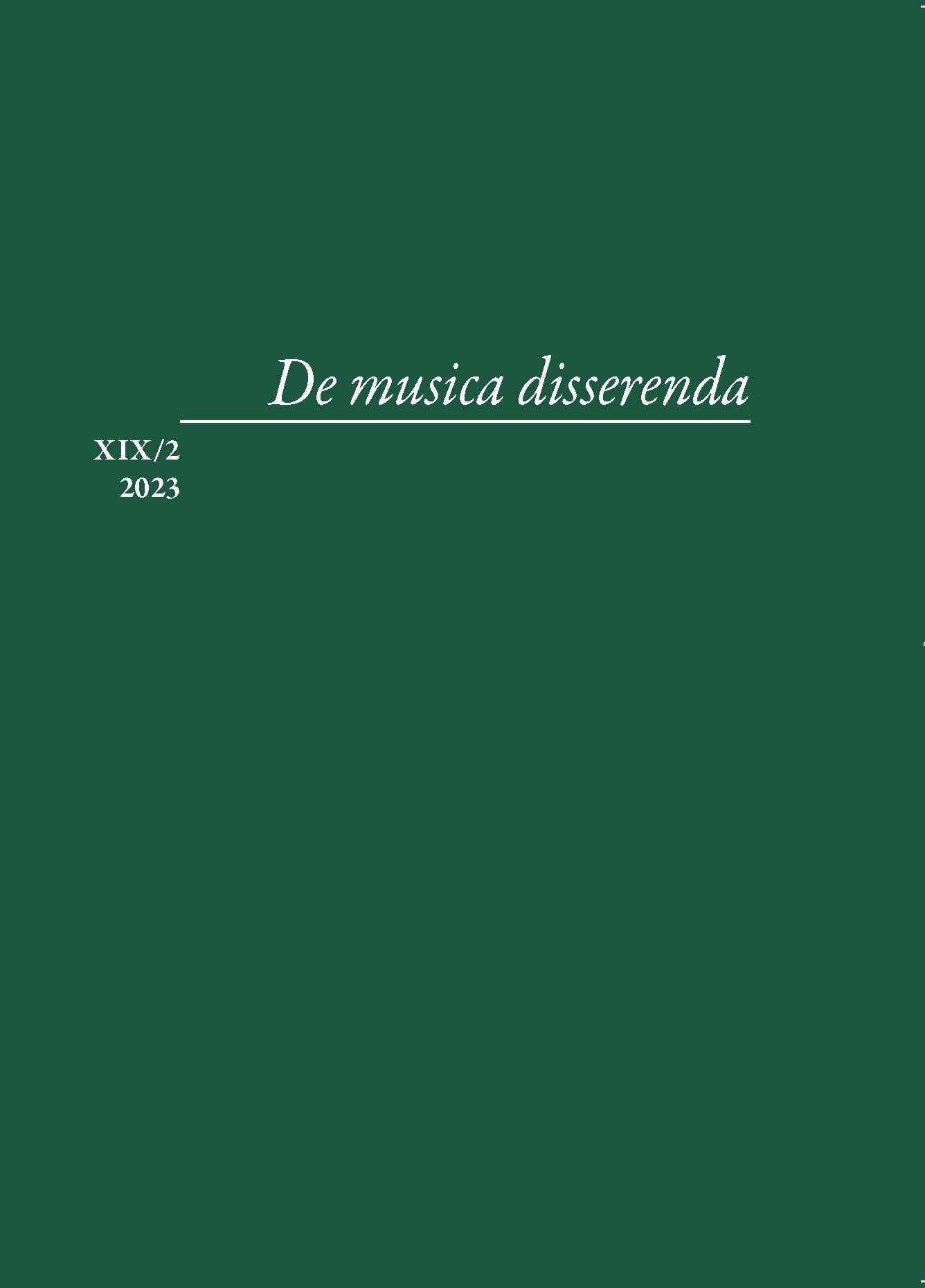Debussy’s Old Hindu Chant (La Boîte à joujoux): Exotic Humorous Fakery and Rejuvenation of Music
DOI:
https://doi.org/10.3986/dmd19.2.11Keywords:
Claude Debussy, exoticism, rāga, musical humour, fakeryAbstract
Debussy’s ballet for children La Boîte à joujoux (1913) contains a fake “Old Hindu chant”. But the comic fakery seems to provide the key to understanding the deep meaning of the ballet, in which Debussy strives to rejuvenate and revitalize Western music by referring to the so-called spontaneity of both childhood and foreign traditions, for the sake of recovered authenticity.
Downloads
References
Bain, Alexander. Les emotions et la volonté. Paris: Félix Alcan, 1885.
Baudelaire, Charles. “The Philosophy of Toys”. In On Dolls, edited by Kenneth Gross, 11–21. London: Notting Hill, 2012.
Bonds, Mark Evan. “Haydn, Laurence Sterne, and the Origins of Musical Irony”. Journal of the American Musicological Society 44, no. 1 (1991): 57–91. https://doi.org/10.2307/831728.
Borio, Gianmario, and Mauro Casadei Turroni Monti. Erik Satie e la Parigi del suo tempo. Lucca: LIM, 2001.
Burnham, Scott. “Haydn and Humor”. In The Cambridge Companion to Haydn, edited by Caryl Clark, 59–76. Cambridge: Cambridge University Press, 2005. https://doi.org/10.1017/CCOL9780521833479.006.
Debussy, Claude. Correspondance: 1872–1918. Edited by François Lesure, Denis Herlin and Georges. Paris: Gallimard, 2005.
Debussy, Claude. Monsieur Croche. Paris: Gallimard, 1987.
De Jong-Kessing, Elisabeth. Inayat Khan: A Biography. Haag: East-West Publications, 1974.
Dufresne, Claude. Jacques Offenbach ou La gaîté parisienne. Paris: Critérion, 1992.
Gauthier, André. Debussy: documents iconographiques. Geneva: Pierre Cailler, 1952.
Herlin, Denis. “André Hellé et La Boîte à joujoux: interview, conférence et texte integral de L’Histoire d’une Boîte à joujoux”. Cahiers Debussy 30 (2006): 97–120.
Inayat Khan, Hazrat. Complete Works of Pir-O-Murshid Hazrat Inayat Khan: Original Texts. Vol. 1. Haag: East-West Publications, 1989.
Jean-Aubry, G. “Some Recollections of Debussy”. The Musical Times 59, no. 903 (1918): 203–209. https://doi.org/10.2307/910278.
Landerouin, Yves. “‘Critique créative’ et ‘critique de créateurs’: Willy et Debussy”. Poétique 155, no. 3 (2008): 333–343. https://doi.org/10.3917/poeti.155.0333.
Langham Smith, Richard. “Pelléas and Gil Blas: Claudine and Monsieur Croche”. In Debussy on Music, 61–73. Ithaca, NY: Cornell University Press, 1977.
Lassauzet, Benjamin. L’Humour de Claude Debussy. Paris: Hermann, 2019.
Lefebvre, Gabriel. Colette. Tournai: La Renaissance du Livre, 2003.
Louÿs, Pierre. Les Chansons de Bilitis. Paris: Librairie de l’Art indépendant, 1895.
Martins, José Eduardo. “‘La boîte à joujoux’ de Claude Debussy e a diversificação analítica”. Revista Música 3, no. 1 (1992): 32–52. https://doi.org/10.11606/rm.v3i1.55037.
Moore Whiting, Steven. Satie the Bohemian: From Cabaret to Concert Hall. Oxford: Oxford University Press, 1999.
Morrison, Simon. “Debussy’s Toy Stories”. The Journal of Musicology 30, no. 3 (2013): 424–459. https://doi.org/10.1525/jm.2013.30.3.424.
Moutal, Patrick. Hindustani Rāga-s Index: Bibliographical References on Descriptions, Compositions and Vistāra-s of Hindustānī Raḡa-s Based on Selected Major Contemporary Works in Devanāgarī. New Delhi: Munshiram Manoharlal, 1991.
“Another Look inside Debussy’s ‘Toybox’”. The Musical Times 117, no. 1606 (1976): 987–989. https://doi.org/10.2307/958273.
Orledge, Robert. Satie the Composer. Cambridge: Cambridge University Press, 1990.
Paul, Steven E. “Comedy, Wit, and Humor in Haydn’s Instrumental Music”. In Haydn Studies: Proceedings of the International Haydn Conference, Washington, D.C., 1975, edited by Jens Peter Larsen, Howard Serwer and James Webster, 450–456. New York: W. W. Norton, 1981.
Peter, René. Claude Debussy. Paris: Gallimard, 1944.
Schadendorf, Mirjam. Humor als Formkonzept in der Musik Gustav Mahlers. Stuttgart: Metzler, 1995. https://doi.org/10.1007/978-3-476-03586-8.
Sheinberg, Esti. Irony, Satire, Parody and the Grotesque in the Music of Shostakovich: A Theory of Musical Incongruities. Aldershot: Ashgate, 2000.
Suarès, André. “Debussy”. La Revue Musicale 1, no. 2 (1920): 98–126.
Valéry, Paul. La Soirée avec Monsieur Teste. Paris: La Nouvelle Revue française, 1896. Volta, Ornella. Érik Satie. Paris: Seghers, 1979.
Wheelock, Gretchen A. Haydn’s Ingenious Jesting with Art: Contexts of Musical Wit and Humor. New York: Schirmer, 1992.
Downloads
Published
How to Cite
Issue
Section
License

This work is licensed under a Creative Commons Attribution-NonCommercial-NoDerivatives 4.0 International License.
Authors guarantee that the work is their own original creation and does not infringe any statutory or common-law copyright or any proprietary right of any third party. In case of claims by third parties, authors commit their self to defend the interests of the publisher, and shall cover any potential costs.
More in: Submission chapter






